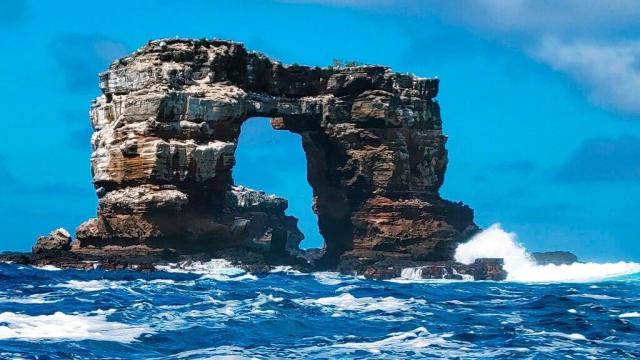The steady march of time has caused Darwin’s Arch — an iconic rock formation in the Galápagos Islands — to collapse.
Tibetan monks will devote dozens of hours to painstakingly create their colourful and elaborate mandalas, only to destroy them in a matter of seconds. Seems pointless, but this exercise is done for a reason. It teaches the key Buddhist doctrine of impermanence — the realisation that all of conditioned existence is transient, fleeting, and alterable. By creating and destroying their mandalas, Tibetan monks are reminding themselves of this doctrine and teaching themselves to accept it.
With news of the collapse of Darwin’s Arch in the Galápagos, I’m also having to remind myself of this principle. But while I accept the impermanence of all things, that doesn’t mean I have to like it.
Informamos que hoy 17 de mayo, se reportó el colapso del Arco de Darwin, el atractivo puente natural ubicado a menos de un kilómetro de la isla principal Darwin, la más norte del archipiélago de #Galápagos. Este suceso sería consecuencia de la erosión natural.
????Héctor Barrera pic.twitter.com/lBZJWNbgHg
— Ministerio del Ambiente y Agua de Ecuador (@Ambiente_Ec) May 17, 2021
This beautiful geological feature, a natural bridge located less than a kilometre from Darwin Island in the Pacific Ocean, is now history. As The Guardian reports, the collapse occurred on Monday, May 17, leaving behind two pillars. In a tweet, Ecuador’s environment ministry said the collapse happened as a consequence of natural erosion — that dastardly, inexorable force responsible for so much of the impermanence we see in the natural world.
“Darwin’s Arch is made of natural stone that at one time would have been part of Darwin Island, which is not open to visits by land,” the ministry added. “The site is considered one of the best places on the planet to dive and observe schools of sharks and other species.”
Incredibly, the collapse was witnessed by divers onboard a ship operated by Aggressor Adventures, as Scuba Diver Life reports.
“Unfortunately today, our guests of the Galapagos Aggressor III experienced a once in a lifetime event. This morning at 11:20am local time, the world-famous Darwin’s Arch collapsed in front of their eyes,” the diving company wrote in a Facebook post. “There are now only two pillars remaining.”
The company said the remaining structure is already being referred to as the “Pillars of Evolution,” which I kind of like. It has a better ring to it than “Darwin’s Pillars,” and the name still honours the legacy of biologist Charles Darwin, who was famously inspired by the Galápagos when he visited the islands in 1835.
The collapse of Darwin’s Arch reminds me of another recent collapse. In January 2020, an earthquake — another engine of impermanence — brought down the Punta Ventana rock arch in Puerto Rico.
Indeed, my ongoing list of natural landmarks made impermanent by impermanence continues to grow, with other examples being Wall Arch in Utah’s Arches National Park (impermanentified in 2008), God’s Finger in Spain’s Canary Islands (made permanently impermanent during a tropical storm in 2005), New Hampshire’s Old Man of the Mountain (lost to impermanence in 2003), and California’s iconic Pioneer Cabin Tree, which developed an impermanent condition in 2017.
